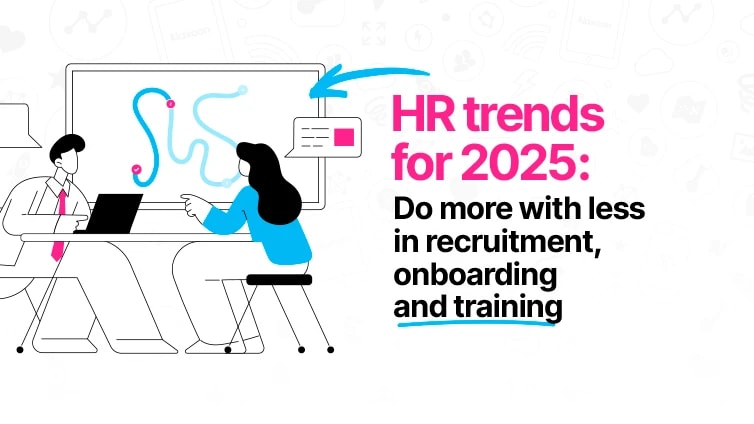6 ways HR teams can transform feedback into actionable insights
Executive summary:
Transforming feedback into actionable input is essential for HR professionals seeking to improve organizational performance. HR feedback acts as a vital link between employees and management, providing perspectives that inform concrete action plans and lead to improved results.
However, simply collecting feedback is not enough. It must be thoughtfully analyzed and acted upon to achieve impactful results.
To maximize the value of feedback, CHROs and HR leaders must foster a culture of open communication and collaboration. By systematically implementing engaging feedback processes, teams can uncover significant results and address pressing issues that impact employee experience and productivity.
This article outlines 6 strategic approaches for HR professionals to turn feedback into actionable practices and ensure seamless integration into existing processes:
- Establish a feedback culture: Foster an environment where employees feel comfortable sharing their thoughts and experiences.
- Leverage technology for feedback collection: Use digital tools and collaboration platforms to streamline the feedback collection process.
- Train leaders on how to value feedback: Equip leaders with the skills to interpret and act on feedback constructively.
- Implement continuous feedback loops: Encourage ongoing dialogue between employees and management to facilitate real-time adjustments.
- Analyze feedback to define patterns: Utilize analytical tools to identify trends and insights that inform strategic decisions.
- Engage employees in the feedback process: Involve employees actively in feedback mechanisms to enhance their sense of ownership and investment.
Ultimately, these strategies lead to more effective HR action plans aligned with employee needs and organizational goals, enhancing overall engagement, satisfaction, and business performance in today’s dynamic workplace.

A good employee experience is a way of ensuring employee engagement and improving everyone's performance.

Transforming feedback into actionable insights is critical for HR professionals seeking to improve organizational performance. HR feedback serves as an essential mechanism between employees and management, providing perspectives that can shape concrete action plans and generate improved performance.
However, simply collecting feedback is not enough. The real task is to analyze it thoughtfully and implement changes based on those insights to drive impactful results.
To achieve this, CHROs and HR leaders must continually foster a culture of open communication and collaboration to maximize the value of feedback. By doing so systematically, teams can uncover significant trends and address pressing issues that impact employee experience and productivity.
This article aims to help HR professionals by outlining 6 strategic approaches they can take to turn feedback into actionable practice, providing concrete solutions that can be seamlessly integrated into existing processes.
From implementing structured feedback loops to training managers on how to use feedback effectively, these methods enable HR professionals to make the most of internal insights. As we explore each strategy, we will highlight their role in developing effective HR action plans, ultimately leading to improved employee engagement and enhanced business performance.
1. Establish a feedback culture
Creating a feedback culture within an organization is foundational for effective HR feedback sharing. Such a culture encourages employees to share their thoughts and experiences freely, knowing their input will be valued and considered.
Establishing a strong feedback culture not only improves the sharing of HR feedback, but also strengthens the overall culture of the organization. It allows HR teams to develop more informed action plans based on actual employee engagement, which can lead to improved participation, morale and retention rates.
HR leaders can promote this culture by implementing regular feedback sessions, encouraging open discussions, and recognizing employees who provide constructive feedback.
Encourage regular feedback opportunities
Organize team rituals that focus on feedback sharing, where employees can express their opinions on various aspects of the workplace and their role.
This could include performance reviews, one-on-one meetings and regular team check-ins to ensure that feedback is an ongoing part of the work environment rather than a sporadic event.
Implement anonymous feedback channels
Providing anonymous feedback options can help employees express their thoughts without fear of judgment.
Tools such as online surveys and asynchronous chats can be instrumental in this process, allowing for honest input that might not otherwise be shared.
Recognize and act on feedback
When employees see that their feedback results in tangible change, they are more likely to contribute in the future.
Therefore, HR teams should regularly communicate how feedback has influenced decision-making to reinforce the importance of sharing insights. Celebrating successes resulting from internal feedback can further motivate employee engagement.
2. Leverage technology for HR feedback collection
Incorporating technology into the HR feedback collection process can significantly improve its effectiveness. Various digital tools and collaborative workspaces enable HR teams to collect and analyze feedback more efficiently.
This can streamline the process and ensure that feedback is collected regularly and systematically, which is essential for identifying ongoing trends and making timely adjustments.
Consider feedback management systems
Implementing dedicated feedback management software allows HR teams to establish feedback collection workflows. These systems can automate surveys, track responses and provide analytical insights, making it easier for HR professionals to identify patterns and trends.
In addition, such systems can facilitate follow-up on feedback, ensuring that employee concerns are addressed in a timely manner.
Implement a collaboration platform
Using a collaboration platform like Klaxoon allows for real-time and asynchronous feedback sharing. It streamlines discussions and enables HR teams to gather valuable insights from employees by allowing them to express themselves in the way that suits them best (orally or in writing):
- Polls
- Surveys
- Informal chats
- Ideas shared on a whiteboard, etc.
Include data analytics
Advanced data analytics can be used to comprehensively analyze feedback. By identifying trends and correlations within feedback, HR teams can develop targeted HR action plans that address specific issues within the organization.
This data-driven approach helps to make informed decisions that are aligned with employee needs and organizational goals.
By using technology to share HR feedback, organizations can ensure that feedback is not only collected, but also analyzed and acted upon effectively.
This leads to actionable insights that drive positive change within the organization and contribute to a culture of continuous improvement, ultimately increasing overall employee engagement and satisfaction.
3. Train leaders on how to value feedback
For HR feedback to be effective, it is crucial that leaders within the organization understand how to use it.
Dedicated training sessions can empower managers and team leaders to interpret feedback constructively and act on it decisively. This training should cover various aspects of feedback, ensuring that leaders are well-equipped to handle feedback appropriately.
Establish effective communication processes
First, leaders must learn how to communicate feedback to their teams effectively. This includes framing feedback positively and constructively, which fosters a culture of continuous improvement rather than defensiveness.
Additionally, training should emphasize active listening skills, enabling leaders to fully understand employee concerns and respond thoughtfully.
Create actionable plans
Training should focus on how to transform feedback into actionable action plans. Therefore, leaders should be equipped with the skills to set clear objectives and outcomes based on the insights gathered.
This includes understanding how to prioritize feedback and develop strategies that align with organizational goals, ensuring that the feedback translates into meaningful changes.
Encourage open dialogue
Encouraging a two-way conversation is essential for maximizing the value of feedback. Leaders should feel comfortable sharing feedback with their teams and inviting input on how changes are implemented.
This approach fosters a sense of ownership and engagement among employees, reinforcing their role in the organization's success.
By training leaders on the importance of feedback and how to use it effectively, HR teams can ensure that feedback is not just collected but actively leveraged to enhance organizational performance. This leads to a more engaged workforce, as employees feel that their voices are heard and valued, ultimately contributing to a positive workplace culture.

In a context of talent shortage, learn how to retain your employees by putting people back at the heart of your organization.

4. Implement continuous feedback loops
Establishing continuous feedback loops is essential to turning HR feedback into actionable insight.
Unlike most feedback exchanges, which occur only when required by the urgency of a situation, continuous feedback encourages ongoing dialogue between employees and management.
This approach allows for short-term adjustments and improvements, fostering a more responsive and adaptable work environment.
Implement regular check-ins
As mentioned previously through team rituals, schedule consistent check-ins between managers and their teams to discuss progress, challenges, and feedback.
These sessions can serve as a central hub for employees to share their thoughts and for managers to provide guidance.
Use pulse surveys
Conducting regular pulse surveys can help HR teams gauge employee sentiment and identify issues before they escalate.
These short, focused surveys allow for quick data collection and analysis, providing insights into employee morale and engagement.
By using pulse surveys, organizations can stay attuned to employee needs and adapt their strategies accordingly.
Encourage peer feedback
Peer feedback can also be incredibly valuable for fostering collaboration and communication within teams.
Encouraging team members to provide constructive feedback to one another can enhance relationships and improve overall performance.
Creating structured peer feedback mechanisms, such as peer review sessions or feedback workshops, can facilitate this process.
Fostering continuous feedback loops creates a dynamic workplace where employees feel empowered to share their insights, leading to timely and relevant HR action plans. Ultimately, this culture of continuous feedback enhances employee engagement, satisfaction, and retention, driving overall organizational success.
5. Analyze feedback to define patterns
Once feedback is collected, analyzing it for patterns and trends is critical to generating actionable insights.
HR teams need to use analytical tools and methodologies to extract meaningful data from feedback, enabling them to identify areas for improvement and make informed strategic decisions. Ultimately, effective feedback analysis strengthens the organization’s ability to foster a positive workplace culture and drive continuous improvement.
Categorize feedback
Firstly, you can try to structure the collected feedback efficiently into categories based on common themes. This can help HR teams identify recurring issues and prioritize areas that need immediate attention.
By classifying feedback, HR can focus on specific challenges, and target interventions.
The use of AI-powered summarizing tools can greatly enhance this process. They can allow you to analyze large volumes of feedback, identify key topics and generate summaries, enabling HR teams to categorize feedback efficiently and accurately.
Use data visualization
Better visualization of data can also improve the understanding and communication of feedback trends. The use of charts, graphs, dashboards and visual management features can help HR professionals effectively present their findings to stakeholders.
This visual representation of data not only makes it easier to view, but also highlights key trends and insights at a glance.
Cross-reference data
Comparing feedback with other metrics, such as employee performance and engagement scores, is another way to gain deeper insights into the organization's strengths and weaknesses.
This approach enables HR teams to develop comprehensive HR action plans that address both immediate concerns and long-term goals.
By understanding how feedback correlates with other performance indicators, HR can make more informed decisions.
6. Engage employees in the feedback process
Finally, involving employees in the feedback process is essential for fostering a sense of ownership and responsibility within the organization.
When employees are actively engaged in providing and acting on feedback, they are more likely to feel valued and invested in the organization's success. This engagement not only improves the quality of feedback received, but also strengthens the overall organizational culture.
Involve employees in feedback design
Involve employees in the design of feedback processes from the outset, including the survey questions and feedback mechanisms mentioned above.
This participatory approach will ensure that the feedback tools resonate with employees and are relevant to their experiences. When employees feel they have a stake in the process, they are more likely to provide thoughtful and honest feedback.
Identify feedback champions
Therefore, empowering employees to act as feedback champions within their teams can also be effective.
These individuals can encourage open discussions about feedback, helping to normalize the practice and ensure that everyone's voice is heard.
Feedback champions can also facilitate workshops or informal meetings that foster a culture of sharing insights and learning from each other.
Communicate outcomes clearly
Finally, communicate the results of feedback initiatives regularly to all employees.
Transparency about how feedback is used to make decisions and shape the organization builds trust and encourages further participation. Sharing success stories or improvements made as a result of feedback can reinforce the value of employee input.
Conclusion
By actively involving employees in the feedback process, HR teams can create a collaborative environment that promotes continuous improvement.
This not only improves the sharing of HR feedback, but also leads to more effective HR action plans that are aligned with employee needs and organizational goals.
Ultimately, fostering a culture of feedback and engagement strengthens the organization's ability to adapt, innovate and thrive in today’s competitive business environment.

Discover the HR trends of 2025 and concrete solutions for staying effective at lower cost.

Unlock your teamwork potential
For free, make your first steps to top-tier work efficiency with the Klaxoon Work Collaboration Platform.